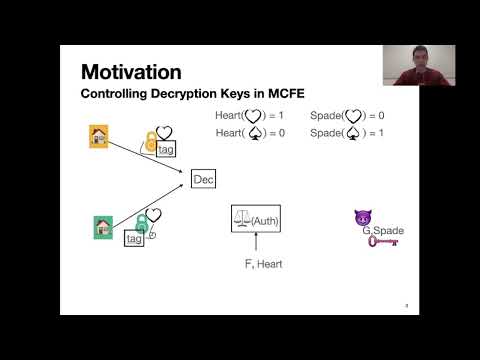CryptoDB
Multi-Client Functional Encryption with Fine-Grained Access Control
| Authors: |
|
|---|---|
| Download: | |
| Presentation: | Slides |
| Conference: | ASIACRYPT 2022 |
| Abstract: | Multi-Client Functional Encryption (\MCFE) and Multi-Input Functional Encryption (\MIFE) are very interesting extensions of Functional Encryption for practical purpose. They allow to compute joint function over data from multiple parties. Both primitives are aimed at applications in multi-user settings where decryption can be correctly output for users with appropriate functional decryption keys only. While the definitions for a single user or multiple users were quite general and can be realized for general classes of functions as expressive as Turing machines or all circuits, efficient schemes have been proposed so far for concrete classes of functions: either only for access control, \emph{i.e.} the identity function under some conditions, or linear/quadratic functions under no condition. In this paper, we target classes of functions that explicitly combine some evaluation functions independent of the decrypting user under the condition of some access control. More precisely, we introduce a framework for \MCFE with fine-grained access control and propose constructions for both single-client and multi-client settings, for inner-product evaluation and access control via Linear Secret Sharing Schemes (\textsf{LSSS}), with selective and adaptive security. The only known work that combines functional encryption in multi-user setting with access control was proposed by Abdalla \emph{et al.} (Asiacrypt '20), which relies on a generic transformation from the single-client schemes to obtain $\MIFE$ schemes that suffer a quadratic factor of $n$ (where $n$ denotes the number of clients) in the ciphertext size. We follow a different path, via $\MCFE$: we present a \emph{duplicate-and-compress} technique to transform the single-client scheme and obtain a \MCFE with fine-grained access control scheme with only a linear factor of $n$ in the ciphertext size. Our final scheme thus outperforms the Abdalla \emph{et al.}'s scheme by a factor $n$, as one can obtain \MIFE from \MCFE by making all the labels in \MCFE a fixed public constant. The concrete constructions are secure under the $\SXDH$ assumption, in the random oracle model for the \MCFE scheme, but in the standard model for the \MIFE improvement. |
Video from ASIACRYPT 2022
BibTeX
@inproceedings{asiacrypt-2022-32404,
title={Multi-Client Functional Encryption with Fine-Grained Access Control},
publisher={Springer-Verlag},
author={Ky Nguyen and David Pointcheval and Duong Hieu Phan},
year=2022
}

